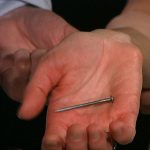 From the Greek “without knowledge of solids,” the inability to recognize objects by touching them even though the sense of touch is intact. This condition is caused by damage to the parietal Lobe of the brain. If the damage is in the right parietal lobe, a person with astereognosis cannot identify objects with his or her left hand, And vice versa. This condition is also known as tactile agnosia, stereognosis, or stereoanesthesia.
From the Greek “without knowledge of solids,” the inability to recognize objects by touching them even though the sense of touch is intact. This condition is caused by damage to the parietal Lobe of the brain. If the damage is in the right parietal lobe, a person with astereognosis cannot identify objects with his or her left hand, And vice versa. This condition is also known as tactile agnosia, stereognosis, or stereoanesthesia.
The inability to identify objects or forms by touch. Agnosia.
A brain disorder characterized by an inability to identify objects by the sense of touch, even when there is no defect of sensation in the fingers or any difficulty holding the object (for example, an individual is unable to identify common objects, such as a coin or safety pin, placed in his or her hands). Astereognosis can occur on the left or right side. It is caused by brain damage to the part of the cerebrum that controls touch.
Loss of the capacity to recognise the nature of an object by feeling it, and indicates a lesion (e.g. tumour) of the brain.
Inability to distinguish objects by sense of touch.
Inability to discriminate between objects of different shapes, textures, weights, or sizes based on touch alone.
Astereognosis is a condition characterized by the inability to recognize objects by touch, even when they are placed in the hand. This difficulty persists despite the absence of any sensory impairment in the fingers or issues with holding the object. Astereognosis can be either left- or right-sided, with normal tactile recognition present on the unaffected side. In cases where both sides are affected, the condition is referred to as tactile agnosia.
Astereognosis and tactile agnosia are attributed to damage in specific regions of the cerebrum, the largest part of the brain responsible for various cognitive functions. These conditions arise when the areas involved in touch recognition are affected. Stroke or head injuries are common causes of such damage, leading to the manifestation of astereognosis and tactile agnosia.
